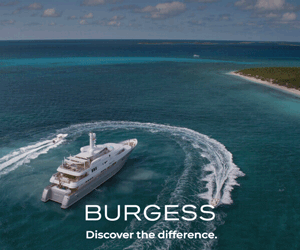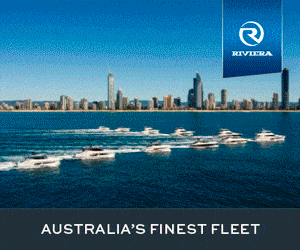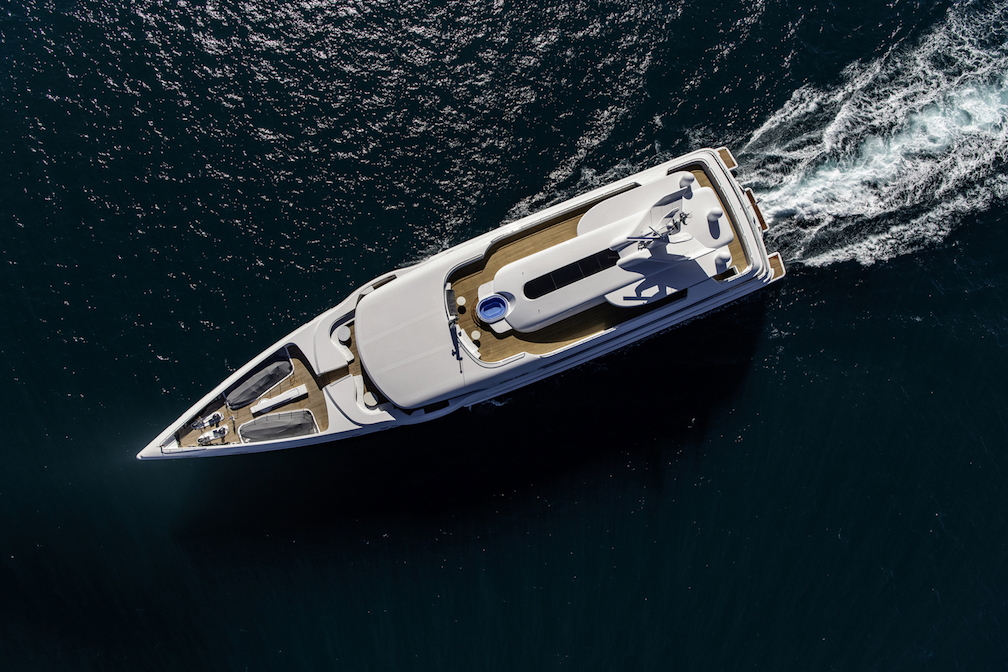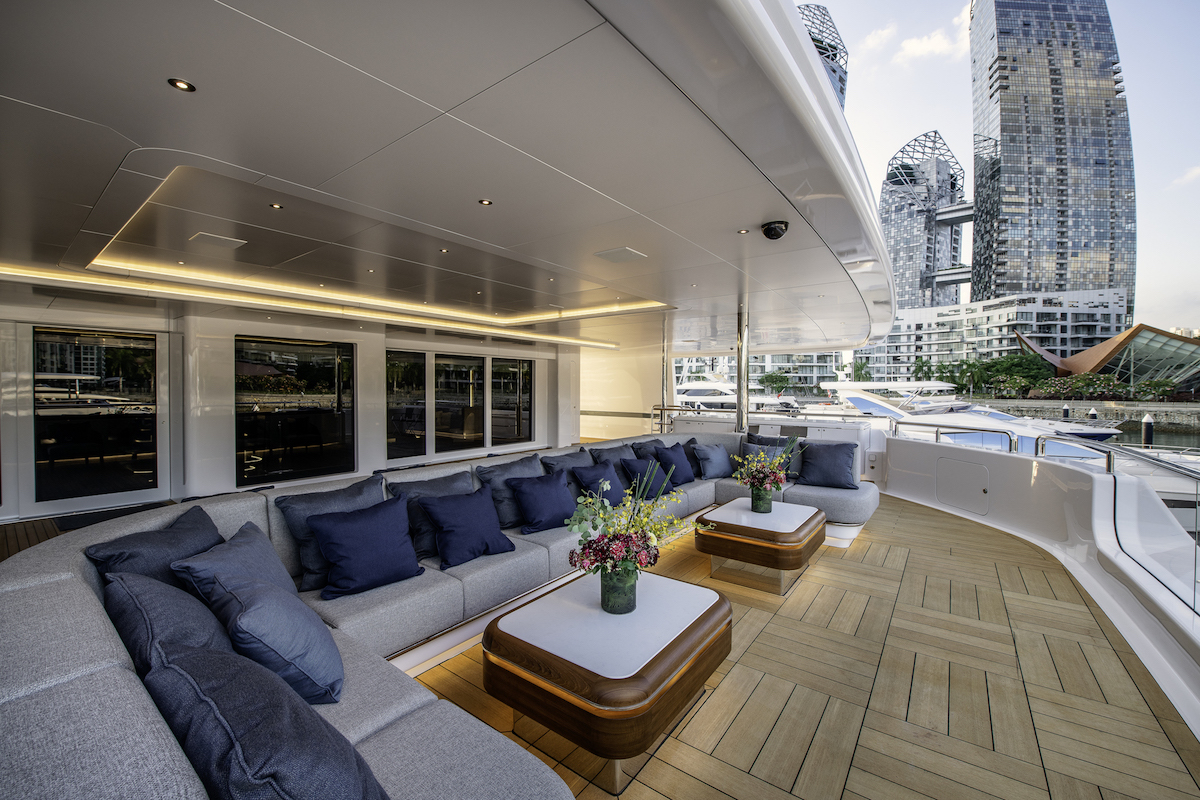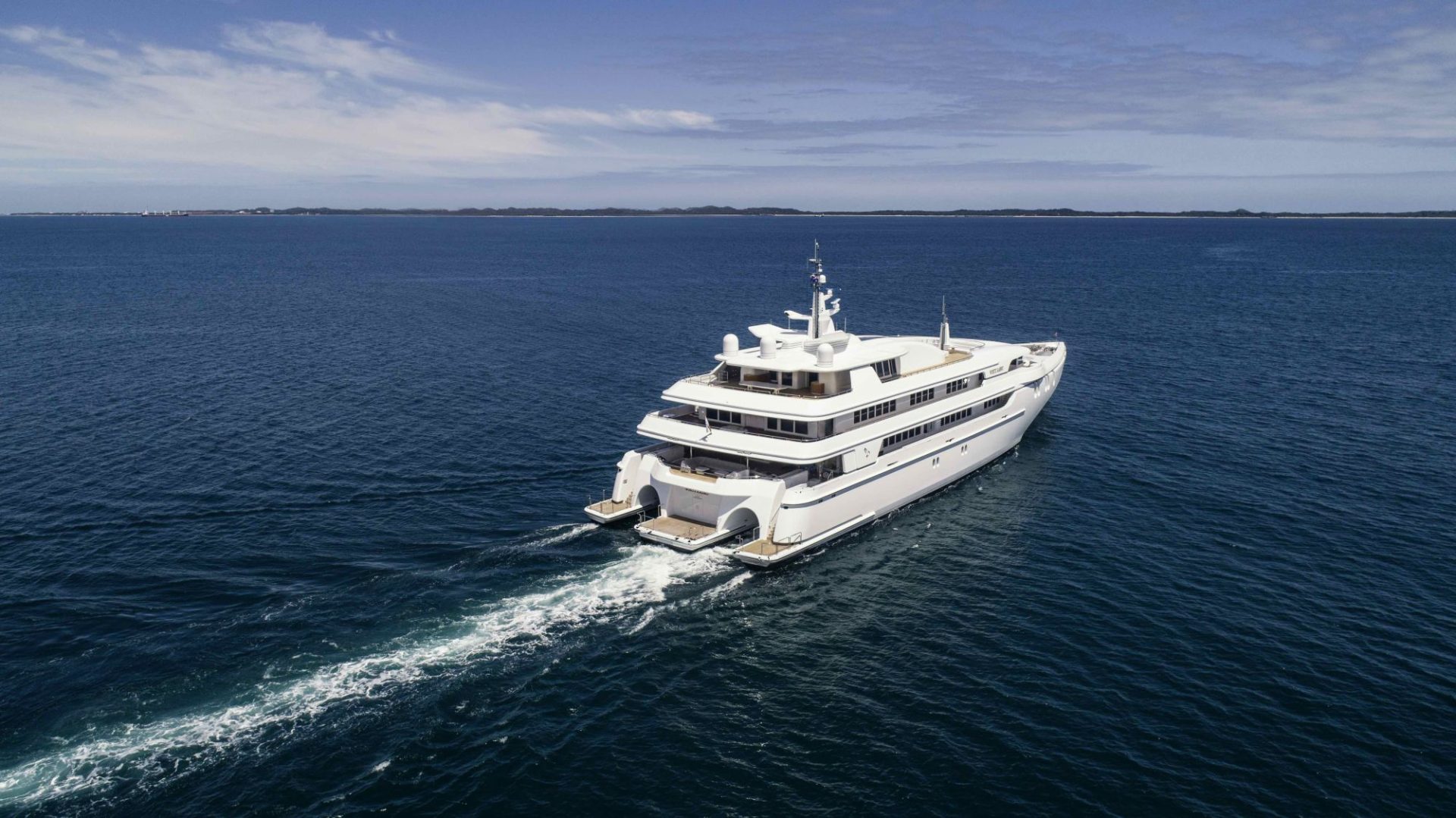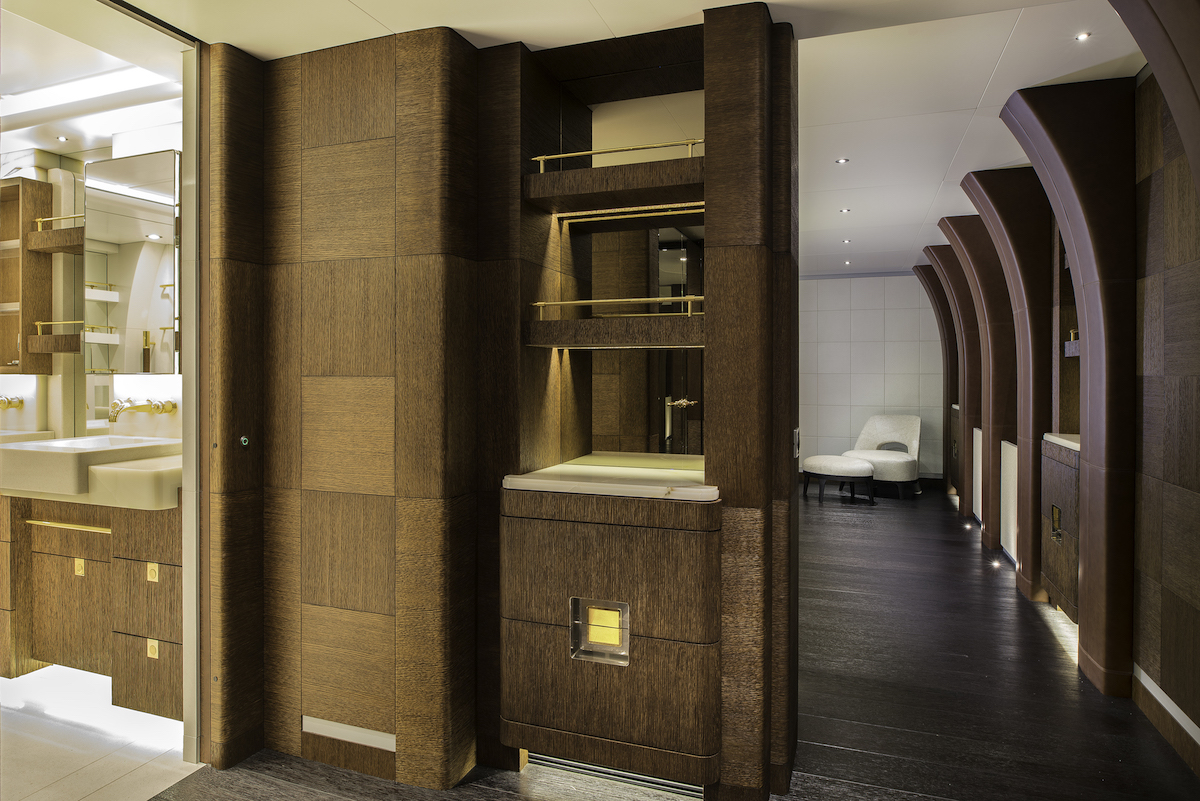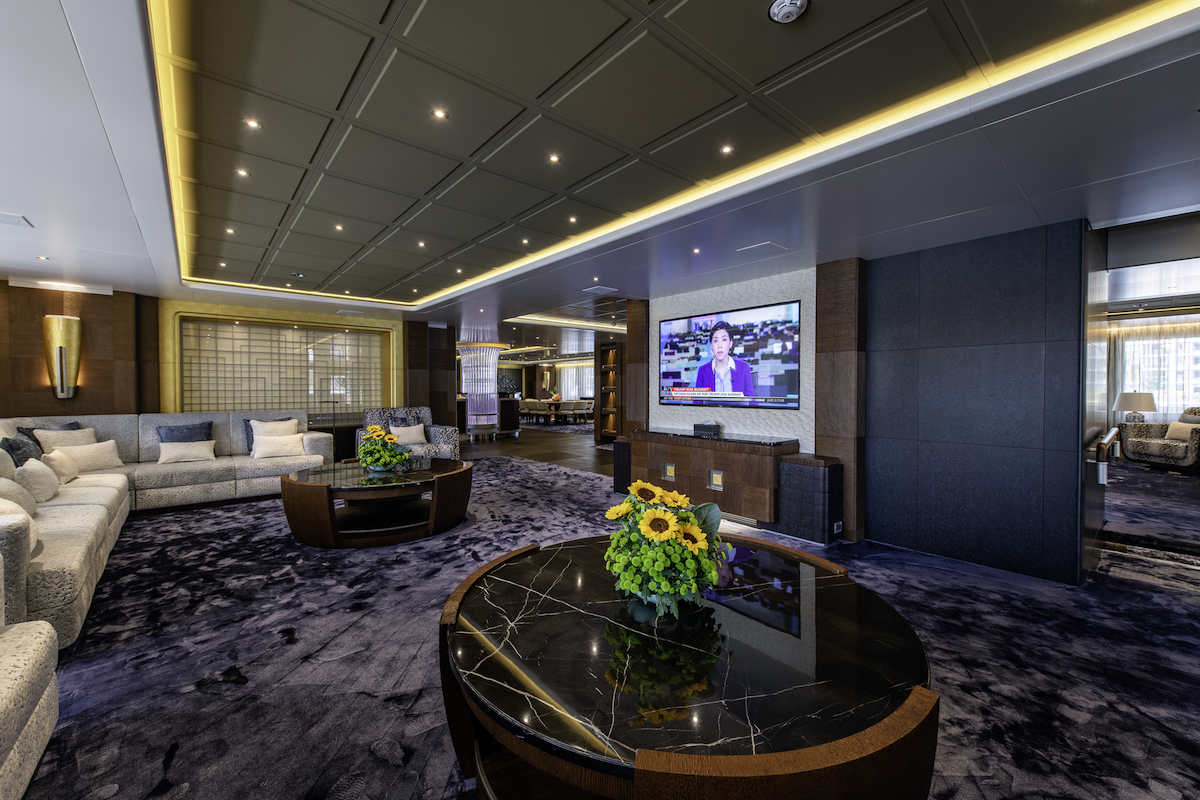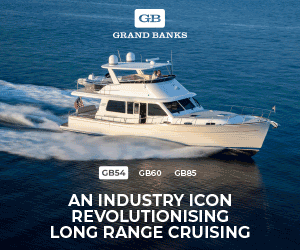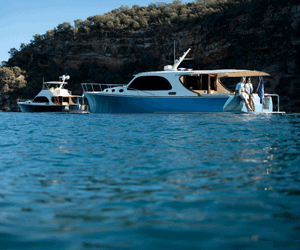Shape shifter
From initial concept to launch, gleaming 84-metre M/Y White Rabbit has shifted the boundaries of the possible. We get acquainted with the largest superyacht ever built in Australia.
Written by Jennie Fitzhardinge
08 June 2019
Viewing White Rabbit from the bow is certainly quite something, the outer hulls arching away from the slender main hull like a predator poised to pounce. In profile, the steep cutaway from the bow to the beginning of the outer hull evokes the streamlined elegance of a spaceship, while from the stern and the aft quarter the yacht echoes a more traditional superyacht design.
According to exterior and interior designer Sam Sorgiovanni, this softening of the radical form of the trimaran with more traditional lines was very deliberate. “We chose to pursue a more classically familiar look for the superstructure because while the tri hull is so striking and aggressive, we wanted to create a classical look that would sit comfortably alongside other vessels,” he explains. “Combined as a whole we hope that the design will generate a feeling of acceptance for this amazing, technologically advanced vessel.”
Innovation is a theme that runs throughout the vessel, from the tip of the navigation mast that doubles as a tender crane to the variable pitch propellers that are driven by a combined diesel/electric system. The origins of this unique vessel are in the owner’s brief and the design team’s willingness and capability to explore all the options.
“The owner is very excited and proud that it’s been an ‘outside of the box’ project from day one,” Sorgiovanni says. “And the decision to build in Australia was natural for him because it is close to home, and he knew from his experience of building White Rabbit Echo that he could get the quality and expertise for a better price than a northern hemisphere shipyard.”
And that is another truth of this project: the innovation is an evolution of experience. In 2005, the owner launched the first trimaran superyacht in the world, the 60-metre White Rabbit Echo. His decision to go with the trimaran format was driven by the need for a platform more stable than a monohull to reduce seasickness. He was also excited by the energy efficiencies offered by a low drag, high-speed hull.
White Rabbit Echo was so successful for the owner and his family that they will be keeping the 60-metre vessel alongside the new 84-metre.
As they explored the options for another White Rabbit, including monohull and catamaran designs, they naturally returned to the trimaran format and the same teams of Sorgiovanni Design, One2Three Naval Architects and Echo Yachts.
The technical brief was for a comfortable, safe, high efficiency and low impact vessel. The overall length of 84 metres and the 20-metre beam was defined by the capacity of the owner’s homeport of Singapore. Excellent low speed manoeuvrability and minimal wash was a priority, both for the marina and the remote islands that the family like to visit. Green anchoring or dynamic positioning systems using bow and stern thrusters was a natural request given that wreck and reef diving is a passion of the family. To cater for the divers’ needs without compromising on the design the owners also added another vessel to their fleet, the 46-metre catamaran Charley, that acts as a shadow vessel and carries the dive equipment, tenders and toys – including a hovercraft – and a helicopter pad. It was also built by Echo Yachts and delivered in 2016.
With most of their trips close to home, White Rabbit can transit at 19 knots, or for blue water passages can cruise at a comfortable 12 knots with a 5,000-natical-mile range.
The trimaran is not a new design concept, but achieving such a large trimaran within the size parameters and accommodation needs is only possible with modern technology. Comprehensive computational fluid dynamic (CFD) testing determined the optimal position of the outriggers in relation to the main hull, both laterally and longitudinally, and the minimum tunnel height. Get any of those factors wrong and the bow waves could interact in such a way to negate any advantage of the trimaran format. CFD was also used to determine the position of the four active spanning foils between the centre and side hulls for ride control. With a total area of 44 square metres when combined with the active integrated trim tab astern, this results in roll and pitch reductions of 60 percent at 16 knots cruising speed in a three-metre sea and significant passive damping at zero speed.
The propulsion system is another factor in the yacht’s comfort. It is powered by a combination of four Caterpillar C32 and two Caterpillar C18 generators which are placed in the outerhulls, and power two 2100kW Stadt electric motors that in turn drive twin
Rolls Royce five blade controllable pitch propellers. Positioning only the electric motors in the centre hull means that there is minimal noise or vibration transferred to the main accommodation: 45 dB according to Echo Yachts. Low speed manoeuvrability is achieved through two Schottel SP57 jets for manoeuvring at less than five knots and a Schottel hubless rim thruster in the bow.
Echo Yachts claims that White Rabbit uses approximately 40 percent less power than a monohull of the comparative gross tonnage to achieve the same top speed. On sea trials the fuel consumption at 12 knots was 362 litres per hour, at 16 knots, 799 litres per hour and at the top speed of 18.7 knots, 1,175 litres per hour, including the house loads of the 2,940GT yacht.
The trimaran offers unique opportunities in terms of accommodation and living areas too. “The 20-metre beam makes for massive spaces,” Sorgiovanni says. “Normally on a monohull you would have to go out to around 160 to 170 metres in length to get that kind of beam.”
Guests experience the generous spaces from the moment they arrive on the main deck. The formal entrance is overlooked by a dramatic marble and silk carpet staircase with the lift behind. To starboard, there is a formal lounge with seating for 10 and on the port side is the family lounge with more informal and flexible seating. From there, the entertaining area opens up to the full beam of the yacht. At the heart of this area is an oval bar with a bespoke colour-changing LED light sculpture that extends from floor to ceiling, flaring out at the top in a classic art deco form. On the port side, a formal dining table which doubles as a board table is topped with a 450kg Bohemian crystal chandelier. It is one of several art pieces that celebrate the beauty of glass, crystal and marble.
“It was very important that the Art Deco design language was similar to White Rabbit Echo because they were keeping her,” Sorgiovanni says.
“However, this was to be a step up as it would be used for both corporate functions – corporate entertaining space is at a premium in Singapore – and private family functions.”
Another surprising design feature of the yacht is that guest spaces were all manufactured
in Turkey to CAD drawings and 3D laser scans supplied by Echo Yachts, then disassembled, shipped to Fremantle and rebuilt within the yacht by the Echo Yachts team in Australia. Such a radical construction method was a major cost saving for the project.
Unusually in superyacht design, the owner’s stateroom on White Rabbit is on the lower deck in the centre hull, where the family elders can ride in comfort. It includes a separate lounge and office, and boasts a full beam ensuite bathroom. It has wheelchair access from the lift and was positioned in this space as the most comfortable for motion while underway. There are two more guest cabins on this deck, a laundry room and six crew cabins.
Forward of the entertainment area on the main deck is a second master suite on the starboard side, enjoying the expansive ocean views. There is also a large galley that is designed to be used by family members, and forward of that are further crew cabins and a crew mess that takes up the full beam. The large windows and elevated position contribute to a light, bright space that would be the envy of superyacht crew the world over. “The yacht will be regularly used in port and at sea so it was important to the owner that the crew is comfortable and content,” says Blackwell.
On the upper deck are three VIP staterooms, four twin cabins and the bulk of the crew accommodation. Overall there is accommodation for 30 guests and 32 crew, and enough space for 100 or more day guests.
The sun deck is optimised for the hot and humid Singaporean weather with large, air-conditioned interior entertainment areas.
The indoor cinema features a skylight that opens up to take in the night sky and a view of the whale tail-inspired main mast.
There are outdoor dining, lounging and sunning areas on each deck with shading and fans to counter the heat. After dark White Rabbit’s custom designed lighting system configures to every mood, right down to underwater hull ports from leading UK manufacturer OceanLED which do away with movable parts to stop vibration.
Walking through White Rabbit there is a sense of coherence, elegance and practicality to the design. Luxury areas are communicated via the materials used – onyx in the VIP staterooms’ ensuites for example – while the cabins most likely to be used by the youngest generations employ more robust materials. The layout is as innovative and unconventional as the yacht herself. The architecture maxim “if you try to design for everyone, you will please no one, the more unique and specific a design is, the better it will be,” certainly seems applicable in this case. From the beginning, this project was customised to the family’s needs, experiences and the expectation that the yacht will remain in the family for generations. And that is a low impact choice in and of itself.


